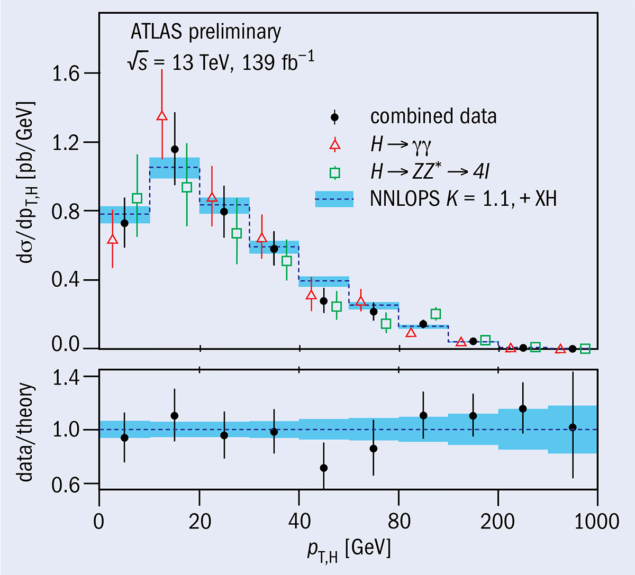A report from the ATLAS experiment

The LHC completed its Run 2 operations in December 2018, delivering a large dataset of proton–proton collisions at a centre-of-mass energy of 13 TeV. The ATLAS detector maintained a high level of readiness and performance throughout Run 2, resulting in 139 fb–1 of data for physics analyses.
An increasingly consistent picture of the properties of the Higgs boson is being drawn in light of the Run 2 data. This is thanks to a wide range of measurements, and particularly through the establishment of its couplings with third-generation quarks following the observation of the H → bb decay and associated ttH production.
The H → γγ and H → ZZ* → 4ℓ final states, where 4ℓ denotes 4e, 2e2μ or 4μ, provide clean experimental signatures that played a leading role in the discovery of the Higgs boson, and are ideal for precision measurements that could reveal subtle effects from new physics. ATLAS presented updated results for these two channels using the full Run 2 dataset at the 2019 summer conferences.
Using improved identification and energy calibration of leptons, photons and jets, and new analysis techniques, a sample of about 210 H → ZZ* → 4ℓ signal events (figure 1) and 6550 H → γγ signal events were selected to perform a series of measurements. The properties of the Higgs boson are investigated by measuring inclusive, differential and per-production-mode cross sections that are sensitive to different modelling aspects.
In the 4ℓ channel, differential cross-section measurements are performed as a function of the transverse momentum of the Higgs boson and the number of jets produced in association with it. The different production mechanisms of the Higgs boson are measured inclusively and in various regions of kinematic phase space, which are cleanly separated by neural networks.
In the high-statistics γγ channel, differential cross sections are measured for a set of variables related to the Higgs boson kinematics, as well as the kinematics and multiplicity of jets produced in association with the Higgs boson. The measured distributions are used to constrain modified interactions of the Higgs boson with SM particles.

The measurements in both channels are found to be well described by the SM predictions. Their combination yields a total Higgs-production cross section of 55.4 ± 4.3 pb, in agreement with the SM prediction of 55.6 ± 2.5 pb. The combined measurement of the transverse-momentum differential cross section (figure 2) has significantly improved in precision compared to earlier results. It is sensitive to the virtual processes governing the dominant Higgs-boson production through gluon fusion and to direct contributions from new physics.
Achieving 8% precision on the Higgs cross section is a significant step towards studying the electroweak symmetry breaking mechanism. Numerous additional measurements are being pursued by ATLAS in the Higgs-boson sector with the full Run 2 dataset to perform detailed tests of SM predictions and hunt for new phenomena.
Further reading
ATLAS Collaboration 2019 ATLAS-CONF-2019-025.
ATLAS Collaboration 2019 ATLAS-CONF-2019-029.
ATLAS Collaboration 2019 ATLAS-CONF-2019-032.





